Do cats dream? What do they dream about? Do they dream in color? Do they dream about their owners? Do they have nightmares? This article will explain everything you need to know about cats and how they dream!
What Do Cats Dream About?
A study of cats and sleep done by neuroscientist and medical researcher Michael Jouvet in 1960s has demonstrated that cats do not only dream, but show hunting-like behavior while dreaming.
In the study, cats during sleep wiggled their tails, hissed their backs and arched as if they were hunting prey.
However, cats could be dreaming about many different things because dreaming is when cats organize and process information about their daily experiences.
Because cats are more tied to their senses than humans are, we suspect that what they dream about also reflects that. They may dream about whatever it means to be a cat – the ideas of relationships, food and treats or toys, or threats.
“Humans dream about the same things they’re interested in by day, though more visually and less logically. There’s no reason to think animals are any different,” says Dr. Deirdre Barrett, an evolutionary psychologist at Harvard Medical School.
Do Cats Dream About Their Owners?
Yes, cats do dream about their owners! In fact, cats dream about everything they experience, and their humans are a part of that.
The electrical activity that takes place in a sleeping cat’s brain is very similar to other mammals. The are of the brain known as the hippocampus, which is responsible for processing memories, is highly active.
This means that, like humans, when cats dream they process memories. However, the way they experience their dreams may be a lot differed, is more likely tied through their senses.
For example, because cats have more than 40x as many odor sensors in their bodies compared to humans, they are more likely to associate the idea of memory through scent, and experience it that way when dreaming. If you wear a characteristic perfume, and your cats recognize it, this is one of the ways they may interpret the memory of you in dreams.
“When they close their eyes, it’s likely that cats have dreams that are a lot like ours.”
Matthew Wilson, MIT
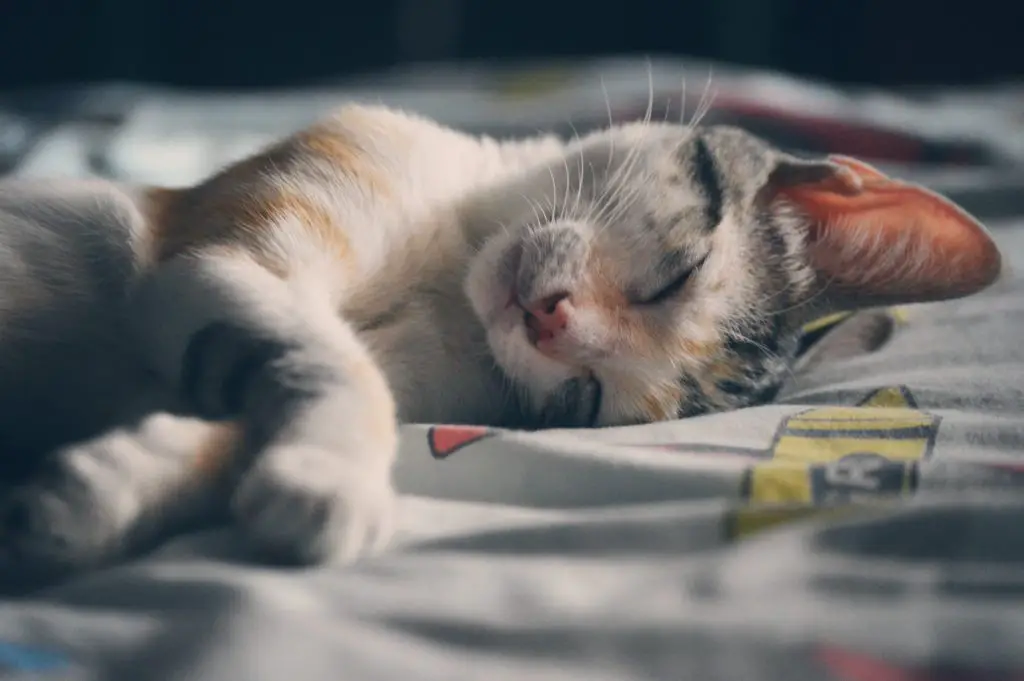
My Cat Has A Nightmare
Did your cat ever woke up hissing and growling after twitching in her sleep, or jolting away with wide eyes, appearing frightened? If so, she may have went through a nightmare.
Nightmares are vivid dreams that may be threatening, upsetting, bizarre or otherwise. Nightmares can be triggered by many factors, from stress or anxiety to other types of trauma and fear, but they are always a way of emotional healing.
Cats, just as people, need a way to cope with stressful situations in life and process their emotions. The best way to do so is through dreaming, when our unconscious is at works.
Contrary to what most people say, having nightmares is not always a bad thing. Research has found a positive association between nightmares and coping with stress.
Although there’s not enough research yet to confirm whether or not cats have nightmares, because research has proven that they do, indeed, dream, and dreams are all about reflecting of our own experiences of reality, it is safe to say cats experience good – and bad – dreams.
What To Do If Your Cat Has Nightmares?
If your cat has nightmares, calm and comfort your cat with some tight cuddles and petting. You can stroke your cat gently will speaking softly and quietly: “It’s OK.”
This will give your cat a sense of safety which is crucial for her wellbeing. Your cat will relax very soon and settle back into sleep.
You can also make sure that your cat does not feel threatened by the immediate physical environment around her. Sometimes the physical environment around us can also affect the way we dream and interpret our dreams, such as the temperature (cats are more sensitive to heat than we humans are) or the amount of oxygen in the air.
Make sure your cat sleeps in a safe corner of the room from which she can have a nice overview of the room, and feel safe. Cover your cat with a nice, warm blanket so she can fall asleep easier. Leave the doors almost closed and not completely open, so that the cat can run outside but knows no one can jump on her as soon as she wakes up.
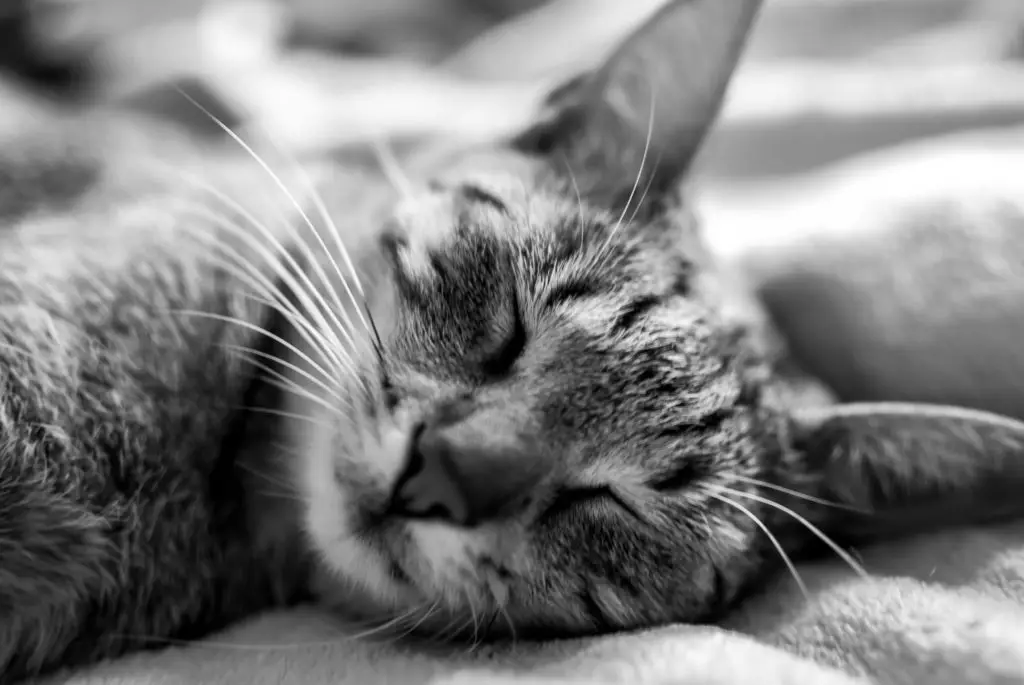
Do Cats Dream In Color?
While no studies have been done yet to confirm whether or not cats dream in colors, scientists suspect so.
It is interesting to note that cats do not appear to perceive the full range of colors that humans can.
Cats do not have the ability to perceive colors in rich, vibrant tones humans do.
A cat’s vision is similar to a human who is color blind. They can see shades of blue and green, but not so much the red and the pinks, which may appear more green-like, while purple can look like another shade of blue.
Cats are also unable to see far objects as well, and their visual acuity is 10 times less than that of a human.
However, cats are more sensitive to the passing of light because of the tapetum, a reflective layer at the back of the eye that allows them to see in low-intensity light. As predators, this advantage allows them to better identify their prey in low light.
Even though cats cannot perceive colors in the same way humans do, they still see colors and may be able to dream in more than just layers of black or white.
We may theorize that although cats can dream in color, color in general is just less relevant for what the cat will experience in dreams and the type of information that the cat will retain from its dream.
How Do You Know If Your Cat Is Dreaming?
Similar to humans, cats dream when they experience REM sleep. REM sleep is the final stage of sleep that happens right before we wake up. For humans, it’s almost like we’re preparing to wake up, and our brain is in a stage of sleep that resembles wakefulness.
When your cat is dreaming, she will be rapidly moving her eyes under her eyelids, twitching her paws or ears and whiskers, wiggling her tail, making squeaking noises or moving her mouth as though she’s nursing or grooming.
Fun fact: all mammals and birds experience REM sleep.
Similarly, in a separate study done by Worcester Foundation for Experimental Biology, several cats were given high doses of growth hormone during sleep, and the effects of it were temporarily blocked by REM sleep, proving how important REM sleep is for cats, a phase of sleep in which cats dream.
Do Cats REM Sleep?
Yes, cats do REM sleep; it is not only a vital part of their sleep that leaves them in good health and optimizes their body state of being during waking hours, but it also has a deeply restorative function for cats and all animals like. REM sleep benefits mood, emotional and physical health of a cat, and it has a crucial function in the brain development of kittens.
While scientists do not yet know why cats sleep so much, they are aware that dreaming occurs while we they are in the REM phase of sleep.
Many studies have yet to prove all the ways REM sleep affects cats, as well as humans!
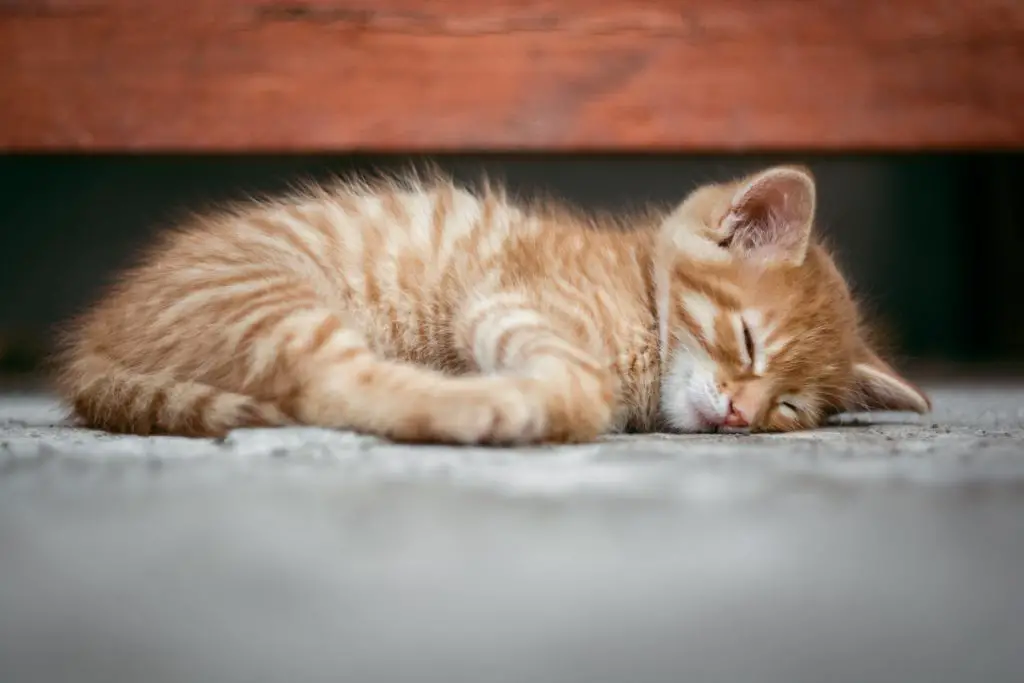
When Do Cats Enter REM Sleep?
REM sleep is the final stage of sleep that for cats occurs right before they wake up. Cats, like humans, go through several different sleep stages and the REM stage is the last one.
Because the average sleep cycle of cats that consists of both NREM and REM sleep lasts for about 22 minutes, and yet cats sleep much more than humans, cats are likely to be dreaming or experiencing REM sleep three times more frequently than humans.
You will notice this because a cat during REM sleep will start twitching its paws, ears, or maybe even wiggle its tail and rapidly move its eyes under its eyelids, which is what REM (Rapid Eye Movement) means. During REM sleep your cat will start displaying some of these attributes.
How Long Do Cats Go Through REM Sleep?
The primary criteria that is used to identify REM sleep are the changes in the electrical activity of the brain, measured by the EEG.
The amount of REM sleep varies among animals – predators experience more REM sleep than pray, and similarly, larger animals tend to spend more time in REM.
On average, cats sleep between 16-18 hours per day, and they dream three times more frequently than humans.
This amount of sleep is then separated by many different sleep cycles. Cats may be taking nap, a light nap, or a longer deep sleep.
One full sleep period consisting of both REM and non-REM sleep lasts for about 22 minutes for a cat.
When cats finally reach the REM phase of sleep, research suggests it lasts more than for humans.
It is also interesting to note that young cats spend more time in REM sleep than older cats, because their brains are still developing.
In comparison, human sleep cycles range from 70 – 120 minutes, and then spend from 10 minutes to 60 minutes in REM sleep, which increases with every new cycle.
Interestingly, several studies have proven that while in utero, all mammals, including cats, spend between 50-80% of a 24-hour day in REM sleep.
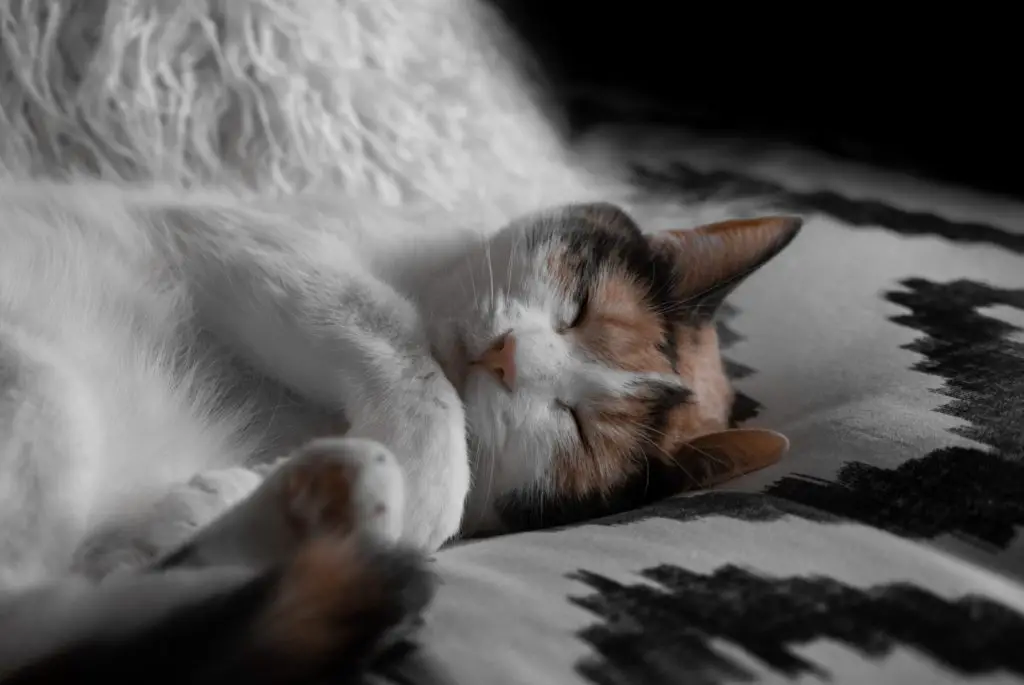
Cat Twitches In Sleep
The American Animal Hospital Association notes that many cats experience small twitches during nap times. Many experts believe that these twitches are quite similar to what humans and other mammals experience during their sleep.
Cat twitch in their sleep due to signals being sent from their brain during the REM stage of sleep.
Although cats might twitch, move their paws and wiggle their tails while they sleep, there’s nothing to worry about! This just means your kitty is sleeping!
Twitching while being asleep is a completely normal and common behavior for cats.
If you’re wondering whether or not to take your kitty to the veterinarian if you see her twitching in its sleep, there’s no no reason to, unless they are also lethargic, and display a variety of other worrying behavior.
“Cats exhibit all the physiological and behavioural characteristics of dreaming sleep in humans: low voltage fast wave activity, fast EEG activity – where the cerebral cortex (thinking centre) and hippocampus (memory centre) are active in the face of continued behavioural sleep.”
Dr. Nicholas H. Dodman

Do Cats Sleepwalk?
While a new study confirmed that surprisingly high amount of humans have had at least once an episode of nocturnal wandering in the last year (approximately 3.6% of all American adults), cats don’t sleepwalk like humans do.
Although cats may move their paws and whiskers while they sleep, only cats with some form of brain damage sleepwalk.
In 1959, a study done by professor Michel Jouvet from Claude-Bernard University in Lyons, France, proved that the generation of REM sleep in healthy cats inhibits the body motor centers associated with movement during sleep.
Jouvet conducted several experiments on cats regarding paralysis associated with REM sleep. He demonstrated that cats with lesions around their brain hemispheres that respond to stress and panic have less restricted muscle movement during REM sleep. Such cats may show a “variety of complex behaviours including motor patterns suggesting that they are dreaming of attack, defence and exploration“.
Should You Wake A Dreaming Cat?
Please avoid waking your cats at all if possible.
REM stage of sleep is especially important for cats because it allows them to restore their body’s immunity. Kittens especially need sleep to allow them to build their bones and muscles.
Even though cats dream and sleep more than humans, dreaming for cats is as important as it is for humans. For humans, a prolonged lack of sleep can be fatal. The same goes for cats.
Did you like our article? Let us know in the comments below!
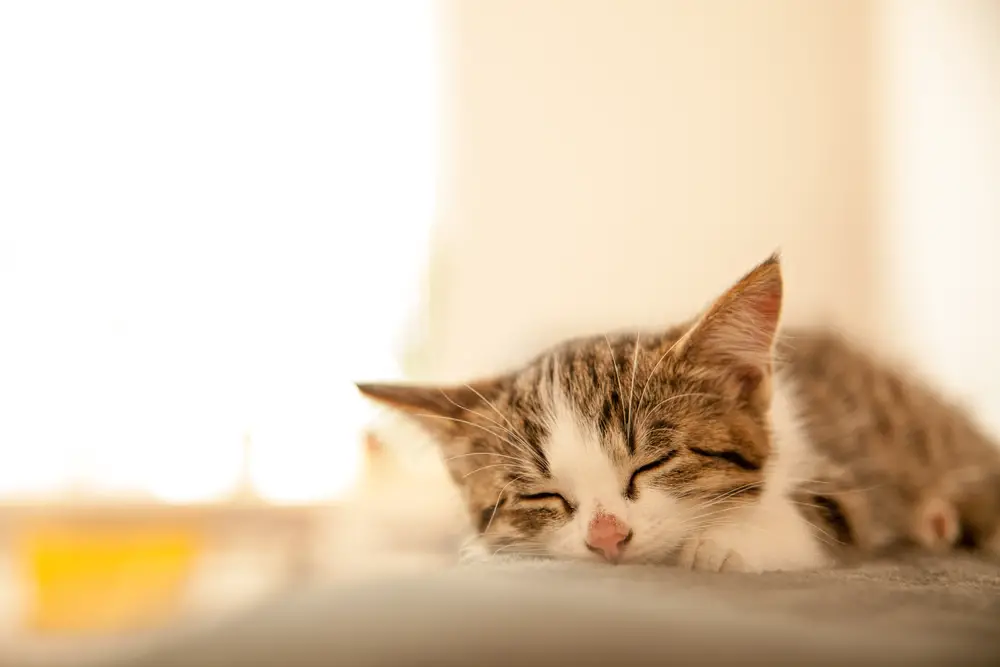
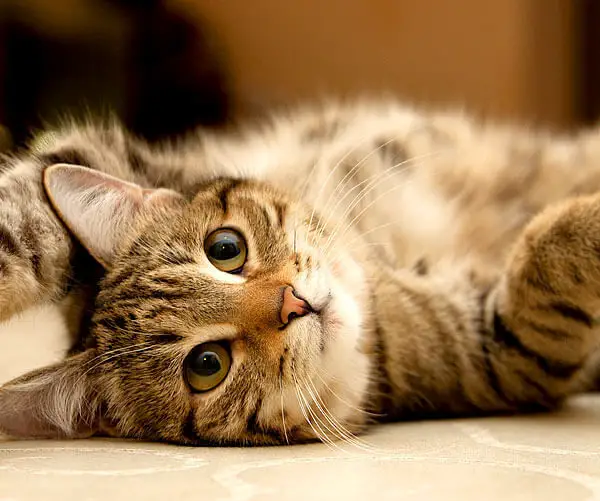

Leave a Comment